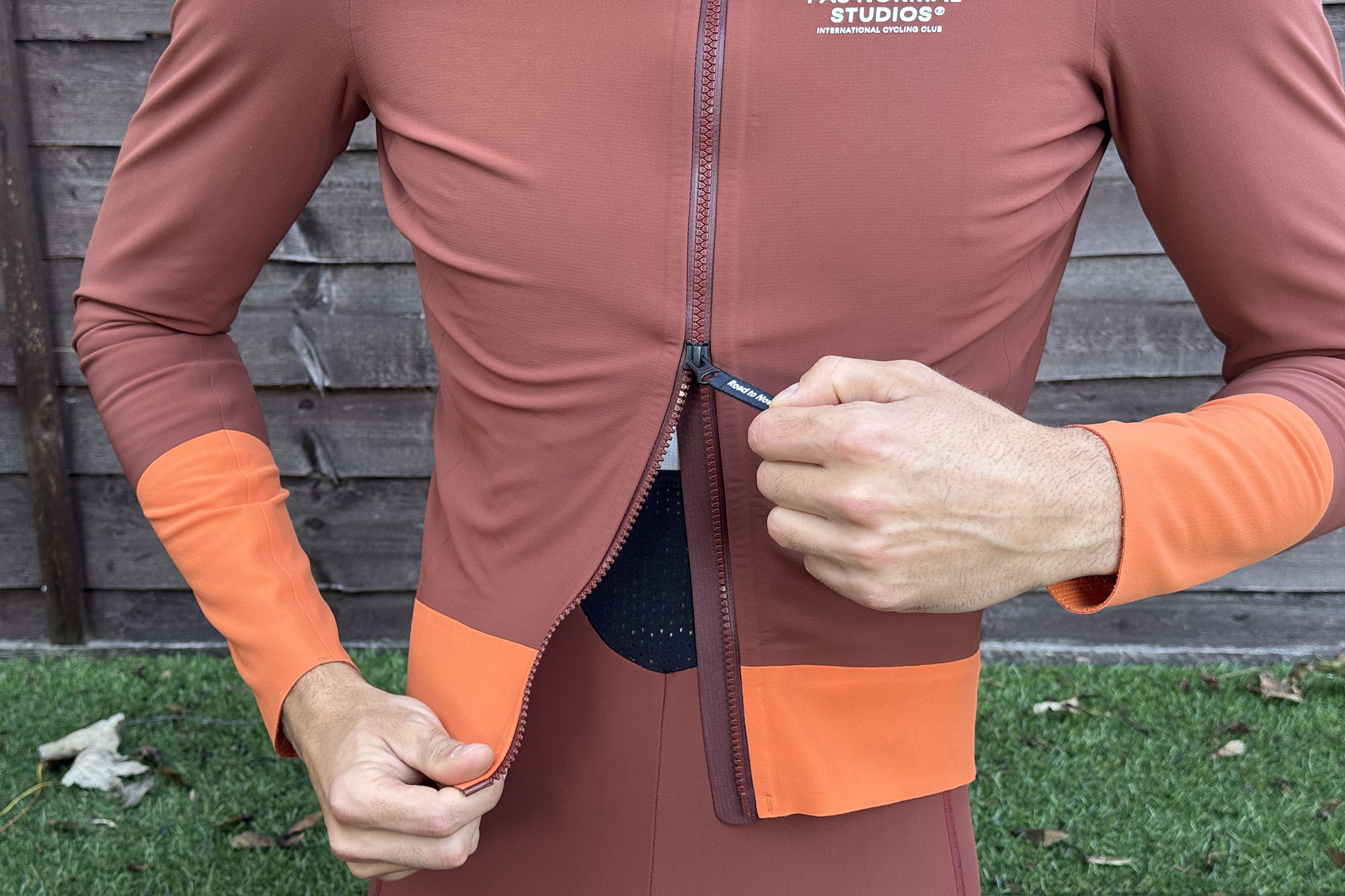
The Pas Normal Studios Mechanism Thermal Jacket packs a lot of features and tech. The jacket is made from a three-layer fabric, with a Windtex Pro membrane and DWR treatment. However, this DWR treatment is more proficient than many, giving the Mechanism Jacket a waterproofing score of 10,000mm water column pressure. Most water-resistant jackets are around 5,000mm, while heavy-duty waterproofs and ski gear are typically 20,000mm. This jacket also features a high level of water vapour transfer, promising to make it highly breathable. Additional weatherproofing comes from the ultrasonic welded, internally taped seams.

The silhouette is race fit, in line with the entire Mechanism range of the PNS kit. Laser-cut hems and sleeves keep the profile looking slick, while the geometry of the jacket pulls you into a more aggressive riding position.
The cut of the jacket is shorter on the body, as has become the fashion recently, but with enough length on the arms. Practical features include a dual-zip to aid temperature regulation, as well as tabs on the lower zip and the zip on the valuables pocket to make them easier to operate with thick gloves on. At the rear, three large cargo pockets have small drainage holes at their bases to prevent water buildup in foul weather. Size-wise, the jacket comes in XXS to XXL with three colours available. The recommended operating temperature is -10 to 8˚C.
The ride

The PNS Mechanism Thermal Jacket is noticeably a fast-paced ride garment. The shoulders pull forwards to get you into that aggressive riding position, while the front is a fair bit shorter than the rear to avoid fabric bunching when you’re tucked over. When cycling, the fit is snug without being constrictive, and in the Medium size, it fits around my body and arms very well. The cuffs extend enough down my arms so that, with gloves on, there was no gap of bare skin visible. The collar achieves a great balance of being high enough to keep the neck warm without being so high as to constrict or get in the way.
My only gripe with the fit of the jacket was that, with the body being on the shorter side, the pockets are high and quite hard for me to reach. I have a long body, but I don’t often have this issue with jackets or jerseys. It’s worth considering if you do have a lanky frame, whereas riders with a shorter body will likely find the fit more ideal.

Staying with the pockets, they are nicely deep, and the holes at the base work well to avoid any water buildup of the sort that would occur in heavier rain because the DWR coating and taped seams do a brilliant job of beading and expelling water. I would rank this DWR performance above most soft-shell jackets I’ve used. Inside, the fleece grid material offers a huge amount of insulation – conditions above 10˚C were too warm for this jacket. Breathability is decent enough, but this jacket’s tour de force is keeping the elements out.

Practicality is another area where this jacket does well. Aside from the pockets sitting a little high, they are very deep for packing food, spares or clothing. I like the handy tabs on the zips for the valuables pocket and lower main front. Using the lower zip to adjust temperature control is really easy, and leads to less fabric flapping than opening the top zip, a design feature I rate.
Value and conclusion

There is, however, one glaring issue with the PNS Mechanism Thermal Jacket, and that’s the £390/$490 price tag. Most good quality winter jackets are generally in the £200-£300/$260-$290 mark, with the even more waterproof Santini Adapt Multi coming in at £240/$300, and the similarly race fit Assos Equipe R Habu winter jacket costing £335/$420. Their Equipe RS Johdah jacket is a frankly huge £635/$750, but that’s a bit of an outlier in the market. It’s pretty easy to get a good quality, good fitting insulated water-resistant jacket for at least £100/$130 cheaper than the PNS.
The fact is there are some very effective winter jackets available for significantly less money. The PNS Mechanism is certainly a brilliantly warm, weatherproofed, practical, stylish, great fitting jacket for fast-paced rides. But it is very expensive. Those who can afford it, and want the brand, style and performance, will not be disappointed, but if value for money is more important, there are plenty of alternatives.







